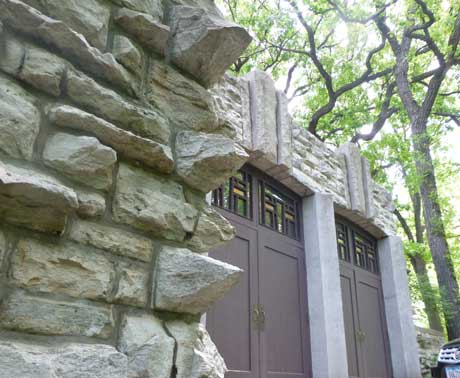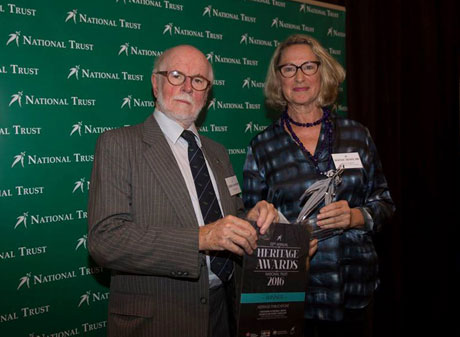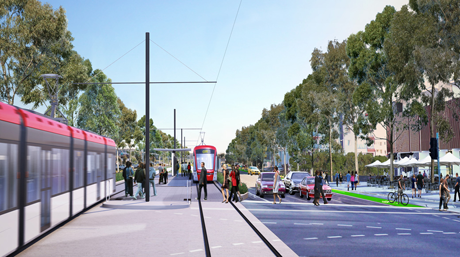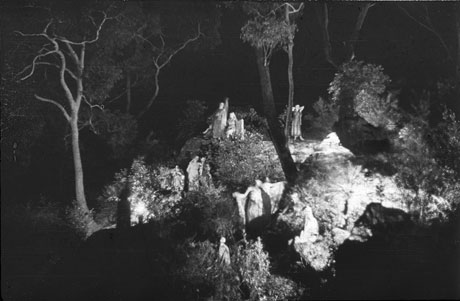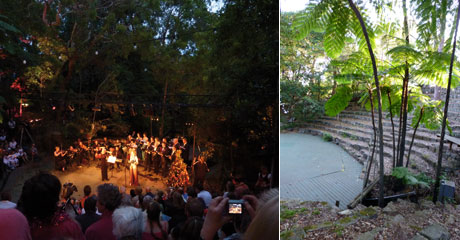Griffin Houses Open Day Saturday 17 September from 10am-3pm Castlecrag
With the assistance of a Willoughby City Council grant the Walter Burley Griffin Society is organising an open day of four Griffin houses with guided walks going between the houses. This is a rare opportunity to see the interior design features of some of the Griffin houses at Castlecrag built in the 1920s and early 30s.
Bookings essential – see the “Events” webpage for further information.
Tickets: www.trybooking.com/212476
Griffin Talks Saturday 17 September 2016 at 4pm
Marion Mahony Griffin Hall, Castlecrag
With the assistance of a Willoughby City Council grant the Walter Burley Griffin Society has organised two illustrated talks in the nearby Marion Mahony Griffin Hall. The first talk The Melson House Revealed: An Owner’s Perspective will be given by visiting American art historian and author Peggy Bang, from Mason City, who is owner of the Melson house.
This will be followed by a talk about Marion Mahony Griffin by senior journalist Glenda Korporaal author of the recently published book titled Making Magic: the Marion Mahony Griffin Story.
Bookings essential – see the “Events” webpage for further information.
Tickets: www.trybooking.com/212489
Canberra and the Five Year ACT Heritage Strategy 2016-2021
Walter Burley Griffin responded to the idealism of the Australian brief for the design competition for the nation’s capital with an ‘Ideal City’ with the potential to capture the imagination of the world.
Early in 2016 the ACT Minister for Planning and Land Management put on exhibition for comment the Five Year ACT Heritage Strategy 2016-2021 Discussion Paper.
The WBGS made a submission with recommendations aimed at the retention of the Griffin vision. The Society recommended that the ACT Heritage Council:-
1. support the extant nominations for Canberra to be placed on the National Heritage List;
2. advocate an integrated sustainability approach to the formation of development proposals and management policies; and
3. enlarge the Heritage Strategy to include re- imagined ‘whole of Canberra’ heritage criteria on the basis of central Canberra’s fundamental DNA in the enduring vision, plans, principles and values provided by Walter Burley Griffin. Reference can be made to outstanding vistas, outcropping hills, the natural landscape, Lake Burley Griffin, its foreshores and the magnificent three-dimensional spatial planning, NCDC district plans and landscape architecture, as well as significant public and domestic architecture. Other ‘whole-of-Canberra’ candidates for the Heritage Strategy would be City Hill, West Basin, Pialligo Estate, Majura Valley rural farm buildings, Hall and Tharwa Villages, Weston and Pryor tree stands and parks, Canberra Nature Park and most starkly, the Manuka precinct.
WBGS letter to the ACT Minister for Planning and Land Management 3/4/2016
National Trust Heritage Award for Visionaries in Suburbia
The Society’s book Visionaries in Suburbia: Griffin Houses in the Sydney Landscape has been awarded the winner of the National Trust Heritage Awards 2016 in the Heritage Publications category.
The 22nd Annual National Trust Heritage Awards took place on Friday 6 May 2016 at the Heritage listed, Doltone House, Jones Bay Wharf, Pyrmont, Sydney. This prestigious event which is highly regarded in the industry, had Quentin Dempster as the Master of Ceremonies, and the Minister of Environment and Heritage, Hon. Mark Speakman as the keynote speaker. The event is the highlight of the National Trust Heritage Festival and was attended by 400 guests including Jack Mundey, and the Society’s Patron John McInerney, President Akky van Ogtrop, Vice President Michael Thomson, and the book’s editor and contributing author Dr Anne Watson.
In announcing the award the National Trust’s President Dr Clive Lucas OBE stated that “This is a beautifully presented book about 22 Sydney houses designed by Marion Mahony and Walter Burley Griffin in the ’20s and ’30s with significant research of some of the lesser known Griffin houses. This book makes a substantial contribution to understanding the legacy of this amazing couple and is a visual feast”.
New Book: Visionaries in Suburbia: Griffin Houses in the Sydney Landscape published by the Walter Burley Griffin Society Inc. September 2015
From Castlecrag to Clifton Gardens, Pymble to Avalon, Visionaries in Suburbia presents for the first time the entire range of Walter Burley Griffin and Marion Mahony Griffin’s Sydney residential designs in the 1920s and 30s. Richly illustrated and with essays by heritage specialists and Griffin home owners, the book reveals new research on some of the lesser-known houses, such as the Pratten and van der Ley residences and a range of unbuilt projects, as well as fresh perspectives on the Castlecrag estate and its unique planning and community concepts.
Not just an architectural survey, Visionaries also explores the Griffins’ holistic vision – the environmental, social and spiritual ideals underpinning their integrated design and landscape philosophy. The book concludes with a chapter on the Griffins’ legacy, the heritage significance of their houses and the relevance of their ideologies today.
Visionaries in Suburbia is illustrated with 270 colour and black and white images – many full-page – including photographs by Max Dupain, Mati Maldre and Eric Sierins, as well as Griffin office drawings and photographs from the Eric Nicholls collection in the National Library and Marion’s incomparable presentation renderings. Contributing an exciting new dimension to our understanding of the Griffins’ milieu are more than 40 previously unpublished photographs of life in Castlecrag from the recently discovered archive of Hermann Junge, a representative for Leica Cameras and a Castlecrag resident in the late 1920s and early 30s.
Coordinating Editors: Dr Anne Watson and Adrienne Kabos
Price: $59.95 available in good bookstores and online at:
http://www.manic.com.au/Visionaries-in-Suburbia-Griffin-Houses-in-the-Sydney-Landscape.html
Canberra's light rail Capital Metro: Slow Tram Coming 11 September 2015
The three trains that run to and from Sydney each day are the only rail services that operate in our nation’s capital. However, 100 years ago, rail was the lifeblood of the infant city of Canberra, delivering the coal that generated its electricity, the bricks produced in its kilns, and the other materials needed at its major building sites.
The bold plan for the city penned by Walter Burley Griffin and illustrated by Marion Mahony Griffin envisaged trams, or ‘street cars’ as they called them, as the means of connecting the residents with their places of employment and recreation. Sadly, only one rail line survived the city’s first two decades of federal administration; the remainder having fallen victim to bureaucratic short sightedness and natural disaster. Today, a locally elected government believes the time has come to resurrect this rail heritage and bring to the city the vibrancy intended by the Griffins.
In September 2014, the Deputy Chief Minister of the Australian Capital Territory (ACT), Simon Corbell announced his approval of the business case for Capital Metro Stage 1, a 12-kilometre light rail service connecting Canberra’s city centre with Gungahlin, Australia’s fastest growing urban area. But as selection of a contractor draws ever nearer, there are still those who criticise the need for the project. At an estimated cost of $783 million, Capital Metro is the largest infrastructure project ever attempted in the ACT.
The Griffins proposed that trams would run along the city’s main avenues and that stations on the Sydney to Melbourne line would be located in the city centre and at the market complex in Russell. In 2004, the National Capital Authority reported in The Griffin Legacy that, “The Griffins’ aim was that 90% of the population would live within a five minute walk of a tram line.”
Any prospects of reviving rail in Canberra were finally thwarted between 1950 and 1953, when the city’s chief planner, Trevor Gibson reduced the width of the main avenues from 300 to 100 feet, making a future tram network unlikely.
Plans for the city’s tram network and the train line to Melbourne were never reinstated, despite a Senate Select Committee concluding in 1954 that, “the more one studies Griffin’s plan and explanatory statements, the more obvious it is that departures from his main principles should not be lightly countenanced.” However, after Walter’s direct participation in the development of the city ceased, a succession of planning bodies replaced the Griffins’ high-density subdivisions with a sprawling cluster of six towns spread over a length of 40 kilometres and separated by the wide green belts of the Canberra Nature Park.
ACT Division members of the Walter Burley Griffin Society accept the need for the Capital Metro Light Rail project, not least because, in essence and as a tentative start, it revives the Griffins’ vision for the nation’s capital. The prospective changes in urban form, infrastructure efficiency and creative long run sustainability in economic, social and environmental terms reflect Griffin’s basic principles of an integrated transport system and organic city development, incorporating a range of potential benefits nowadays encompassed by sustainability.
However, members have significant reservations about the route alignment, location of stations, making of place reservations and the lack of a metropolitan-wide plan. Several of us have conveyed a number of questions and ideas to the Metro Project Team and participated in reference group urban design workshops on Northbourne Avenue and City stations. Luke Wensing has been appointed by Capital Metro to the Public Transport and Engagement Advisory Panel, which reviews the Community Reference Groups.
There have been notable proposals for trams in Canberra. In the 1980s, the Canberra Tradesman’s Union Club planned to fund a tram route through the city centre to promote tourism. In 1992 development company Canberra Land offered to build a light rail line in exchange for land on almost the same alignment being proposed for Capital Metro.
In 1997 the Conservation Council for the South East Region and Canberra, supported by funding from the Canberra Business Council and expert advice from Peter Newman and Paul Mees, issued a comprehensive transport strategy, including light rail under the title Canberra at the Crossroads: a way out of the transport mess. In 1998, the firm Bishop Austrans proposed a light rail service between the airport and the city centre. Neither Liberal nor Labor ACT Governments responded to these initiatives.
In a media statement on 14 August 2015 announcing that he would not be seeking re-election in 2016, Minister Corbell said that during his final fourteen months in office he would “particularly look forward to seeing the first stage of a Canberra-wide light rail network begin construction next year.” He is resolutely supported by Chief Minister Barr notwithstanding major budget issues.
Capital Metro is developing a Light Rail Master Plan for the Gungahlin-Civic stage to integrate all forms of transport. The planning is currently extended to a link from the City along Constitution Avenue to the Defence precinct of Russell, attracting strong support from business and community groups. This latter scenario affords Canberra a main chance to create a station with mixed land use activities at this node of the National Triangle.
The ACT Shadow Transport Minister, Liberal MLA Alistair Coe questions the very need for Capital Metro saying that, “Canberra does not need light rail. The government knows that realigning bus services could achieve the same result at a fraction of the cost.” This will be the case that the Liberals will be taking to ACT residents before the 15 October 2016 election.
The federal Assistant Infrastructure Minister Jamie Briggs warned Mr Coe not to cancel contracts after the 2016 ACT election, labelling the move “economic lunacy.” More recently, Prime Minister Tony Abbott pointed to Capital Metro as an example of how such projects should be funded.
It would appear that after a century of frustration and inaction that, notwithstanding the lack of a metropolitan-wide plan, the Griffins’ vision for rail transport in our nation’s capital might finally be a step closer to reality. Although not everyone agrees that Capital Metro can deliver the promised benefits, it is a chance to revive the challenge and excitement of the planned ‘ideal city.’
From a paper by Joseph Biggerstaff
Edited by Brett Odgers in discussion with Rosemarie Willett, Ann and Bruce Kent and Luke Wensing
Haven Amphitheatre update March 2015
Marion Mahony Griffin was the driving force behind the establishment in the early 1930s of the Haven Valley Scenic Theatre, an open-air theatre for the community created in the natural glen at Castlecrag beside the foreshore reserve and the waters of Middle Harbour, Sydney. Local sculptor and stonemason Bim Hilder, along with the Griffins and other members of the community, built the amphitheatre by creating seating out of sandstone blocks on the western side of the glen.
As Marion Mahony Griffin describes in her memoir The Magic of America:
“No man-made imitation of indoor theatre here but every fairy creation carefully, religiously safeguarded; wattles, different kinds, so golden blossoms for each month in the year…”
“The rest of the valley is the stage, trees and bush and blossoms and rocks to meet any dramatic requirement. To the North a steep rock wall with a long terrace – a road in fact above the eye running East and West. Above it terrace on terrace of spectacular rocks and shrubbery and grand trees. To the East a flat terrace above the eye so scenes can appear and disappear across it, mysterious or spectacular. Then the little stream flowing down to the sea, its head and its further bank offering a rich range of settings – terraces, huge boulders, exquisite varied shrubbery – dainty Lily of the Valley trees and majestic Angophoras…” (page 430)
Following Walter Burley Griffin’s death in 1937, Marion Mahony Griffin’s return to Chicago in 1938 and then World War II (with the requirement for complete blackout at night) performances ceased.
In 1943, three reserves including the amphitheatre were given to Council by Marion Mahony Griffin in trust for the community.
In 1976 the amphitheatre was resurrected by the community and a timber stage, designed by local architect Robert Sheldon ‘that touches the earth lightly’, was built by the community. The design received a Royal Australian Institute of Architect NSW Chapter Commendation Award in 1977. The timber stage was extended in 1992, again to a design by Robert Sheldon.
In 2012, the Haven Amphitheatre Committee prepared a concept that proposed building a new stage in concrete. Concerned about this, the Walter Burley Griffin Society sent a detailed illustrated letter to the Haven Amphitheatre Committee and Willoughby City Council.
In 2014 Willoughby City Council commissioned an independent report on the timber stage which revealed that the existing timber structure is generally in a sound condition but that the structural members of the stage are undersized and need strengthening/rebuilding to achieve Australian Standards load rating for the stage capacity. Despite the favourable report by structural engineers, it was decided to close the stage and prepare new design options for stage improvements.
The Council published these reports on its website and called for comments. Attached is the Walter Burley Griffin Society’s letter dated 7 March 2014 to the Council.
The Council organised a site meeting and the Walter Burley Griffin Society documented its concerns and important aspects of the Deed in a letter to the Councillors dated 23 July 2014.
During 2014, the local community groups-the Castlecrag Progress Association, Castlecrag Conservation Society, the Walter Burley Griffin Society and the Willoughby Environment Protection Society-prepared a joint perspective of the elements they wished to see incorporated into any new stage design. Willoughby City Council called for nominations to a community consultative group that will meet three times during the design preparation process. Experienced planner and Griffin Society committee member Margaret Petrykowski represents the Society on this group. In mid-February 2015, Council appointed Craig Burton from CAB Consulting to prepare design options for the stage improvements. Members of the community consultative group will provide local insight and knowledge into the design preparation process.
It is the unconventionality of the Haven Amphitheatre that makes it so special. Its uniqueness, irregularities, idiosyncrasies and natural bushland beauty need to be preserved and not damaged in any way. There is no other amphitheatre like it in the world.
Any proposal for redeveloping the Haven Amphitheatre needs to completely respect the natural landforms, rocks, creek, trees and bushland of the site, and ensure they are not damaged in any way. In 100 years time when any new structure has decayed, it should be able to be removed leaving the glen uncompromised in its natural splendour.
The Haven Amphitheatre is a community resource that should remain understated, in keeping with the original aims of the Griffins.
Performances in the 1930s at the open-air Haven Scenic Theatre in Castlecrag utilised the amphitheatre’s natural rocky terrain for dramatic effect. Nicholls Collection, National Library of Australia. nla.pic-vn3961885.
At left Carols by Candlelight on Christmas Eve, 2009. At right tree ferns growing at the creek and the original stone seating beyond, 2013.
Proposed new planning laws threaten heritage and conservation areas
Among the aims of our Society is promoting the preservation and conservation of landscape designs, buildings and other works designed by or having an association with the Griffins. Thus the Society is active in many spheres of environmental and heritage conservation throughout Australia, and we maintain a keen interest in preserving the character of the Griffin Conservation Area in Castlecrag.
We are particularly concerned about the potential impact of the new ‘reforms’ to the state planning system currently being proposed by the NSW Government, which has released draft legislation in the shape of two Planning Bills scheduled for introduction to Parliament within the next three months. These new bills would change the planning system of NSW drastically and many of the pillars on which it’s built would be removed.
The proposal to centralise decision making with the Minister and Director-General for Planning & Infrastructure would remove many of the checks and balances of the present system.
Major effects would be to rob communities of the ability to participate in planning decisions at their local level, and to reduce the need for decision-makers to consider the social, environmental and heritage impacts of new development. We are particularly fearful that protection for conservation areas and much of our heritage will be stripped away. Repeal of the EP&A Act 1979 means that after a transition period, there would no longer be Development Control Plans (DCPs), and we can find nothing in the exposure bill that might give protection to heritage conservation areas or even items of local heritage.
In order to be better informed about the proposed laws, we have joined the Better Planning Network (BPN), established in August 2012 and which now, less than 10 months later, includes close to 400 community groups.
In the BPN Key Issues and Submission Guide, it states:
– “Local plans must protect all existing heritage-listed items (both State and local) and all heritage conservation areas currently identified in Local Environmental Plans. Strategic planning must also be comprehensively undertaken to identify currently unlisted heritage and establish new heritage conservation areas in the future. As it stands, the Planning Bill contains no recognition of the importance of Heritage Conservation Areas and no indication that Heritage Conservation Areas or items of local heritage significance will be afforded any protection.
– Consideration must be given to creating a heritage-specific conservation zone for Heritage Conservation Areas, within which any development would be automatically merit-assessed.
– Complying and code assessable development must be prevented in environmentally sensitive areas, within Heritage Conservation Areas, in the immediate vicinity of any heritage item”…
– The impetus for the new planning system is a reactive response to the need for more housing which tilts the planning system in favour of the development industry at the cost of community wellbeing, our environment and heritage.
– A convincing argument has not been established by the State Government for many of the proposed reforms which are essentially using the planning system to drive economic growth. This seems to be a direct response to pressure from the development industry, but one likely to alienate the community from planning decisions that directly affect them, diminish the role of local government in the planning process and result in detrimental impacts on the built, heritage and natural environments”.
Prescriptive controls such as maximum floor space ratio (FSR) limits and height limits are essential to restrict the size of development in conservation areas. They should not be removed as proposed in the draft legislation.
The changes proposed to our planning system are radical and threaten heritage conservation areas including the Griffin Conservation Area. We urge you to make your voice heard on this matter. Comments on the new planning system close on Friday 28 June 2013 at
– www.engage.haveyoursay.nsw.gov.au/newplanningsystem
– or post your submission to: New Planning System, NSW Department of Planning and Infrastructure, GPO Box 39, Sydney NSW 2011
Even more important is to send a copy or write to:
– Premier Barry O’Farrell MP Parliament of New South Wales
office@premier.nsw.gov.au
– your local Member of Parliament, Parliament of New South Wales.
Their name and address can be found at:
www.parliament.nsw.gov.au
– Reverend the Hon. Fred Nile, MLC, Parliament House, Macquarie Street, Sydney NSW 2000
F.Nile@parliament.nsw.gov.au
– The Hon. Paul Green, MLC, Parliament House, Macquarie Street
Sydney NSW 2000
paul.green@parliament.nsw.gov.au
– Federal Minister for Sustainability, Environment, Water and Population and Communities, and Minister for the Arts,
The Hon. Tony Burke MP, Member for Watson, NSW
PO Box 156, Roselands, NSW, 2196
Tony.Burke.MP@aph.gov.au
Further information
http://betterplanningnetwork.good.do/
Better Planning Network Key Issues and Submission Guide, June 2013:
https://docs.google.com/file/d/0B1phj5J6584wYlZfMWZLT3FKQjQ/edit?pli=1


